In your mind palace, you imagined something beautiful. You had an adrenaline rush, as you eventually started to evolve the imagination. It touched your heart. But it was still a figment of your imagination. Hence, you decided to record and sketch it, to witness how it looks like in reality. Eventually it gave fruition to your art and design.
Folks, that’s exactly what we did with the LightCube Matrix Generator. We sketched an idea in our head and thought how about simulating matrices of light-cubes using just one! To get our idea into a realistic eye-candy visual, the Nvidia Omniverse platform gave us the power to augment our imagination. With the help of Omniverse Code and some basic geometry, we were able to program a UI tool which would help you generate light-cubes with several patterns!
In this blog, we are going to guide you how to use our Omniverse Extension to create some beautiful (m x n) lightcube matrices.
What Is Nvidia Omniverse

Before we delve into uncharted territories, it’s the best to know a bit about them.
Omniverse Code – An IDE to empower developers with the necessary tools to create extensions, applications and microservices
Omniverse View – Facilitates review of 3D design projects in collaboration powered by photo realistic environments
Omniverse Create – Provides an environment for building massive worlds and composing scenes with USD workflows
Other interesting offerings from Nvidia Omniverse include Audio2Face, Machinima, CreateXR, DriveSim, IsaacSim and Kaolin
System Requirements
The official requirements vary in the Omniverse range of applications. But they can be found in the official documentation. In general, one needs to pack at least an RTX 2070 Ti, 8 Gigs of RAM, a powerful Octa-Core CPU and 256 Gigs of SSD.
Getting Familiar
The above video from Nvidia can be a good start to make you familiar with the basic intricacies of using Omniverse Code. We recommend the readers to also follow the official documentation to get familiar with the associated jargons.
A Quick Glimpse
Here is a short video showcasing our extension in action. Feel free to watch it.
Enabling the extension
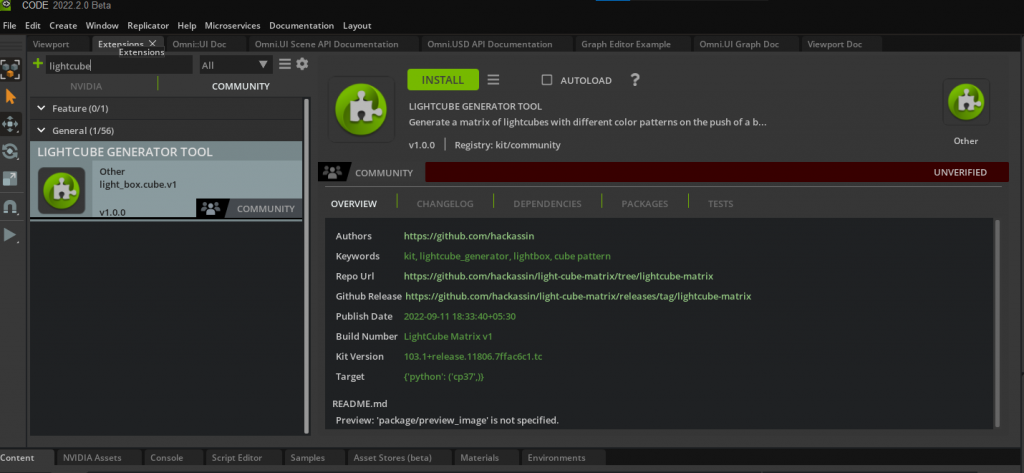
1. Navigate to the extension tab and search for ‘lightcube’ in the community section
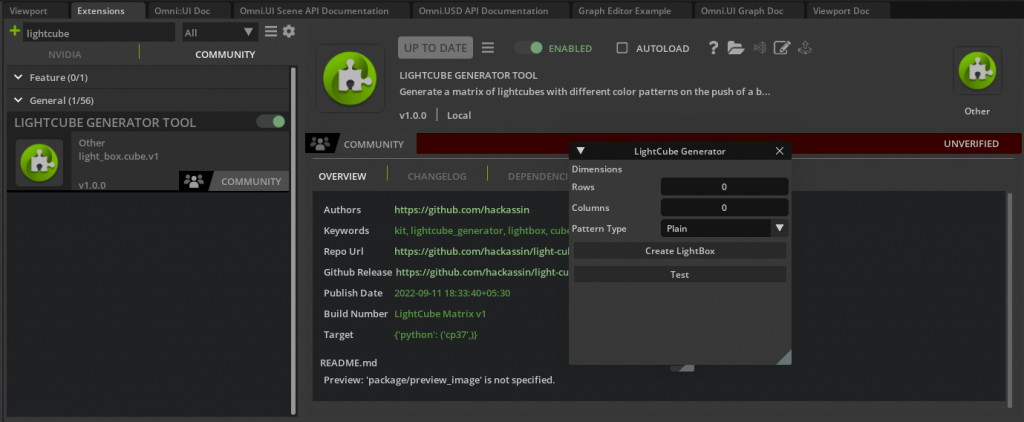
2. Install and toggle the enable button to start playing with the extension. You will notice the UI popup for LightCube Generator tool.
3. Please note, in order to use the extension, you will need the source asset for the same. It is located in the extension repo path: exts\light_box.cube.v1\light_box\cube\v1\assets\lightcube.usd
Using the extension
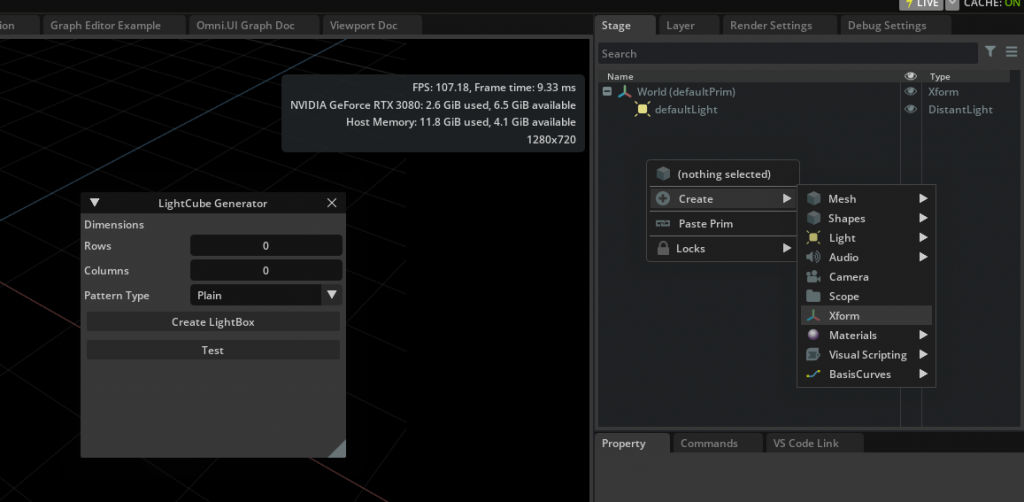
1. You must create a new XForm. After creating, head to Edit tab in Omniverse Code and click on ‘unparent’ to move the XForm out of the Root/World primitive.

2. Once the above is done, drag the ‘lightcube.usd’ file to XForm group.
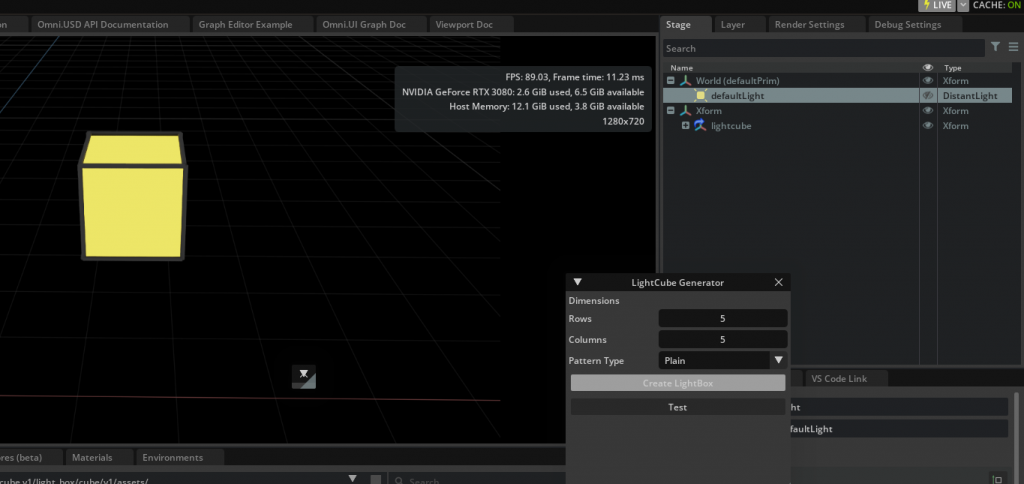
3. On the extension UI window, titled ‘LightCube Generator’ you can find the fields for specifying number of rows and columns for the lightcube matrix.
4. Click on each field and drag/enter your desired dimensions.

5. Below that you shall notice the ‘PatternType’ field which is meant for specifying the lightcube matrix color pattern.
6. Choose your pattern type out of ‘Plain’ (singular color), ‘Diagonal’ (diagonally singular color) and ‘Random’ (random colors).
7. Hit the generate button to produce your LightCube Matrix.
Supported Pattern Types
Currently, only three pattern types are supported. They are:
Plain
Generates lightcube matrix with cubes having the same color

Diagonal
Generates lightcube matrix with the diagonal cubes only retaining the same color.

Random
Generates a randomized color pattern for all the cubes in the matrix.

How This Helps You
If you want to augment the environment of your funky world with some cyberpunk lights, this extension can assist you a lot. On the push of a button, you shall be able to generate multiple lightcube matrices thus minimizing your effort. From an industry perspective, this could serve as an asset to architects or game developers who want to design cool environments in a minimal time frame. Definitely, you can go ahead and dabble with the code to define even more interesting patterns or add more features.
We would love to hear back from you how you like it or are willing to collaborate to make this extension even sassier!

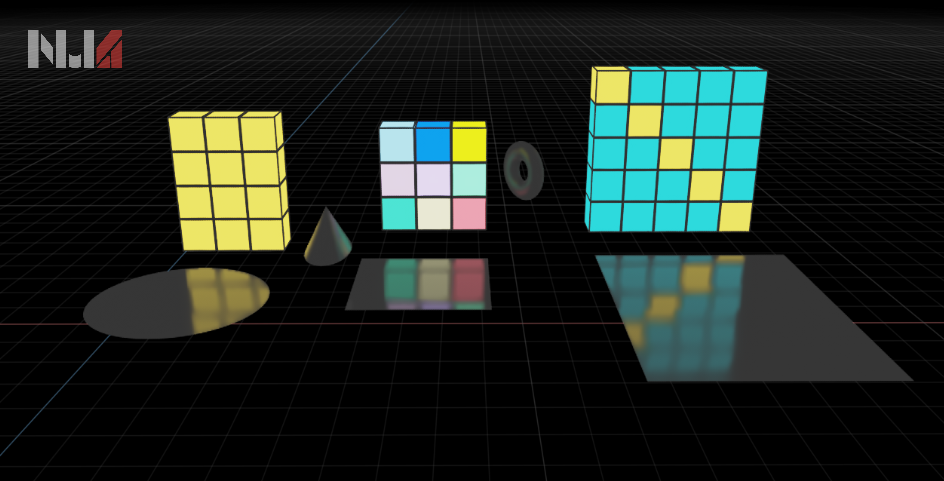
1 Comment